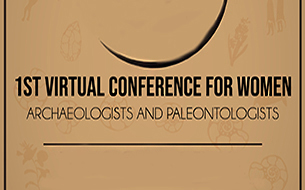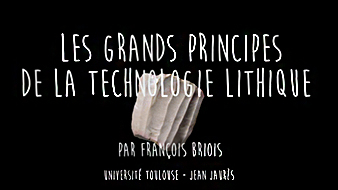Notice
Identification of embalming material of bird mummies through molecular and compound-specific δ13C analyses / Alex Malergue
- document 1 document 2 document 3
- niveau 1 niveau 2 niveau 3
Descriptif
Identification of embalming material of bird mummies through molecular and compound-specific δ13C analyses / Alex Malergue, in colloque "1st Virtual Conference for Women Archaeologists and Paleontologists. Nouveaux apports à l’étude des populations et environnements passés" organisé par le laboratoire Travaux et Recherches Archéologiques sur les Cultures, les Espaces et les Sociétés (TRACES) de l’Université Toulouse Jean Jaurès et le laboratoire Paléontologie Évolution Paléoécosystèmes (PALEVOPRIM) de l'Université de Poitiers, sous la responsabilité scientifique de Julie Bachellerie, Ana Belén Galán López (Traces), Émilie Berlioz et Margot Louail (Palevoprim). Université Toulouse Jean Jaurès, 8-9 mars 2021. [Conférence enregistrée à distance].
Session 3 : Exploitation of natural resources and raw materials, subsistence strategies.
The molecular and isotopic analysis of organic residues is used more and more frequently in archaeological studies, to provide an insight into the chemical composition and potential origin of organic materials used by ancient civilizations. In Ancient Egypt, some humans and animals were mummified following a precise process, some parts of which are still unknown. There are a lot of questions concerning the balms used for mummification: which materials were used to produce this balm? Was the same ‘recipe’ used in all Egypt? My Master thesis aims at analysing and comparing the molecular and isotopic compositions of the balm of twenty different bird mummies (Ibis and birds of prey) from known locations, to determine if it is possible to differentiate their method of production and/or potential origin(s) based on their chemical composition. I will present the basic principles and goals of my study, the methods used, preliminary results and perspectives.
Thème
Documentation
Références documentaires
JONES, Jana, HIGHAM, Thomas F. G., CHIVALL, David et al. (2018). A prehistoric Egyptian mummy: Evidence for an ‘embalming recipe’and the evolution of early formative funerary treatments, Journal of Archaeological Science, vol. 100, 191-200. [En ligne : https://www.sciencedirect.com/science/article/pii/S0305440318304114].
BUCKLEY, Stephen A., CLARK, Katherine A., EVERSHED, Richard P. (2004). Complex organic chemical balms of Pharaonic animal mummies, Nature, 7006, vol. 431, 294-299. [En ligne : https://www.nature.com/articles/nature02849].
Liens
Programme du colloque "1st Virtual Conference for Women Archaeologists and Paleontologists" (8-9 mars 2021)
Website du Laboratoire Paléontologie Évolution Paléoécosystèmes Paléoprimatologie (PALEVOPRIM)
Livret des résumés des communications du colloque "1st Virtual Conference for Women Archaeologists and Paleontologists. Nouveaux apports à l’étude des populations et environnements passés" (8-9 mars 2021)
Site internet dédié au colloque "1st Virtual Conference for Women Archaeologists and Paleontologists" (8-9 mars 2021)
Dans la même collection
-
Sensivity analysis to morphological changes of the shoulder joint: application to percussio…
Blasi-ToccacceliAliciaSensivity analysis to morphological changes of the shoulder joint: application to percussion gestures during Oldowan debitage / Alicia Blasi-Toccacceli, in colloque "1st Virtual Conference for
-
"Ouranopithecus macedoniensis" (late Miocene, Greece): analysis of mandibular fragments using …
IoannidouMelaniaOuranopithecus macedoniensis (late Miocene, Greece): analysis of mandibular fragments using 3D geometric morphometrics / Melania Ioannidou, in colloque "1st Virtual Conference for Women
-
Comminution capabilities of extant and fossil anthropoids during molar intercuspation: a preliminar…
WalkerAxelle E. C.Comminution capabilities of extant and fossil anthropoids during molar intercuspation: a preliminary experiment using a chewing simulator / Axelle E. C. Walker, in colloque "1st Virtual Conference for
-
New sperm whale cranium from the late Miocene and a revised family attribution for the small crown …
AlfsenApollineNew sperm whale cranium from the late Miocene and a revised family attribution for the small crown physeteroid Thalassocetus / Apolline Alfsen, in colloque "1st Virtual Conference for Women
-
What is shaping the brain? A perspective on brain size evolution in carnivorans / Margot…
MichaudMargotWhat is shaping the brain? A perspective on brain size evolution in carnivorans / Margot Michaud, in colloque "1st Virtual Conference for Women Archaeologists and Paleontologists. Nouveaux
-
Postnatal shape changes in the rodent mandible at a macroevolutionary scale / Morgane Dubied
DubiedMorganePostnatal shape changes in the rodent mandible at a macroevolutionary scale / Morgane Dubied, in colloque "1st Virtual Conference for Women Archaeologists and Paleontologists. Nouveaux apports à l
-
Cranial vault healing in modern humans: input of archaeological and clinical data / Aliéno…
LepetitAliénorCranial vault healing in modern humans: input of archaeological and clinical data / Aliénor Lepetit, in colloque "1st Virtual Conference for Women Archaeologists and Paleontologists. Nouveaux
-
A transdisciplinary approach to reconstruct the Nilotic socio-ecosystem in Luxor west bank during t…
NicatoreGiuliaA transdisciplinary approach to reconstruct the Nilotic socio-ecosystem in Luxor west bank during the Ptolemaic period (3rd-1st centuries BC.) / Giulia Nicatore, in colloque "1st Virtual Conference
-
Tracing Human Ancestral Migration from its Symbiotic Bacteria / Alexia Nguyen Trung
Nguyen TrungAlexiaTracing Human Ancestral Migration from its Symbiotic Bacteria / Alexia Nguyen Trung, in colloque "1st Virtual Conference for Women Archaeologists and Paleontologists. Nouveaux apports à l’étude des
-
From monoliths to megaliths: a new approach on the megalithic burials of southwestern France / Bosc…
BoscusSarahFrom monoliths to megaliths: a new approach on the megalithic burials of southwestern France / Boscus Sarah, in colloque "1st Virtual Conference for Women Archaeologists and Paleontologists. Nouveaux
-
Foragers and their symbolic landscape. Understanding the role of rock art in the territoriality of …
JobardLéaForagers and their symbolic landscape. Understanding the role of rock art in the territoriality of Later Stone Age Matobo populations / Léa Jobard, in colloque "1st Virtual Conference for Women
-
Towards a tracking of past bird seasonal migrations through geological times: what could isotopes t…
DuhamelAnaïsTowards a tracking of past bird seasonal migrations through geological times: what could isotopes tell us? / Anaïs Duhamel, in colloque "1st Virtual Conference for Women Archaeologists and
Sur le même thème
-
Sensivity analysis to morphological changes of the shoulder joint: application to percussio…
Blasi-ToccacceliAliciaSensivity analysis to morphological changes of the shoulder joint: application to percussion gestures during Oldowan debitage / Alicia Blasi-Toccacceli, in colloque "1st Virtual Conference for
-
"Ouranopithecus macedoniensis" (late Miocene, Greece): analysis of mandibular fragments using …
IoannidouMelaniaOuranopithecus macedoniensis (late Miocene, Greece): analysis of mandibular fragments using 3D geometric morphometrics / Melania Ioannidou, in colloque "1st Virtual Conference for Women
-
Cranial vault healing in modern humans: input of archaeological and clinical data / Aliéno…
LepetitAliénorCranial vault healing in modern humans: input of archaeological and clinical data / Aliénor Lepetit, in colloque "1st Virtual Conference for Women Archaeologists and Paleontologists. Nouveaux
-
From monoliths to megaliths: a new approach on the megalithic burials of southwestern France / Bosc…
BoscusSarahFrom monoliths to megaliths: a new approach on the megalithic burials of southwestern France / Boscus Sarah, in colloque "1st Virtual Conference for Women Archaeologists and Paleontologists. Nouveaux
-
Study of human group behaviors during the Last Glacial Maximum in the east Carpathian area from zoo…
DemayLaëtitiaStudy of human group behaviors during the Last Glacial Maximum in the east Carpathian area from zooarchaeological remains / Laëticia Demay, in colloque "1st Virtual Conference for Women Archaeologists
-
From sooty speleothems analysis to the study of occupation dynamics of caves by prehistoric societi…
VandeveldeSégolèneFrom sooty speleothems analysis to the study of occupation dynamics of caves by prehistoric societies / Ségolène Vandevelde, in colloque "1st Virtual Conference for Women Archaeologists and
-
Gender Trouble: towards a deconstruction of binarity in archaeology / Laura Mary
MaryLauraGender Trouble: towards a deconstruction of binarity in archaeology / Laura Mary, in colloque "1st Virtual Conference for Women Archaeologists and Paleontologists. Nouveaux apports à l’étude des
-
An analysis of Iron Age Scottish wetland deposition practices /Tiffany Treadway
TreadwayTiffanyAn analysis of Iron Age Scottish wetland deposition practices / Tiffany Treadway, in colloque "1st Virtual Conference for Women Archaeologists and Paleontologists. Nouveaux apports à l’étude des
-
“Feeling at home”: integration of Polynesian women inside pre-existing societies of Vanuatu (Melane…
ZingerWanda“Feeling at home”: integration of Polynesian women inside pre-existing societies of Vanuatu (Melanesia) / Wanda Zinger, in colloque "1st Virtual Conference for Women Archaeologists and Paleontologists
-
Study on the origins of iron metallurgy in North-East Madagascar (11th-16th century): Reinvention o…
MorelMélissaStudy on the origins of iron metallurgy in North-East Madagascar (11th-16th century): Reinvention or technology transfer? / Mélissa Morel, in colloque "1st Virtual Conference for Women Archaeologists
-
Analysis of Artefact Form: the application of morphometric methods to archaeology / Renata Pedroso …
AraujoRenata Pedroso deAnalysis of Artefact Form: the application of morphometric methods to archaeology / Renata Pedroso de Araujo, in colloque "1st Virtual Conference for Women Archaeologists and Paleontologists. Nouveaux
-
La technologie lithique : les grands principes / François Briois
BrioisFrançoisLa technologie lithique : les grands principes / François Briois, chercheur au laboratoire "Travaux et Recherches Archéologiques sur les Cultures, les Espaces et les Sociétés" (TRACES / Université




















